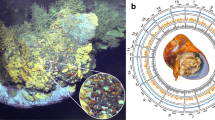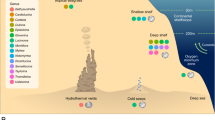Abstract
Bacteria containing magnetosomes (protein-bound nanoparticles of magnetite or greigite) are common to many sedimentary habitats, but have never been found before to live within another organism. Here, we show that octahedral inclusions in the extracellular symbionts of the marine bivalve Thyasira cf. gouldi contain iron, can exhibit magnetic contrast and are most likely magnetosomes. Based on 16S rRNA sequence analysis, T. cf. gouldi symbionts group with symbiotic and free-living sulfur-oxidizing, chemolithoautotrophic gammaproteobacteria, including the symbionts of other thyasirids. T. cf. gouldi symbionts occur both among the microvilli of gill epithelial cells and in sediments surrounding the bivalves, and are therefore facultative. We propose that free-living T. cf. gouldi symbionts use magnetotaxis as a means of locating the oxic–anoxic interface, an optimal microhabitat for chemolithoautotrophy. T. cf. gouldi could acquire their symbionts from near-burrow sediments (where oxic–anoxic interfaces likely develop due to the host’s bioirrigating behavior) using their superextensile feet, which could transfer symbionts to gill surfaces upon retraction into the mantle cavity. Once associated with their host, however, symbionts need not maintain structures for magnetotaxis as the host makes oxygen and reduced sulfur available via bioirrigation and sulfur-mining behaviors. Indeed, we show that within the host, symbionts lose the integrity of their magnetosome chain (and possibly their flagellum). Symbionts are eventually endocytosed and digested in host epithelial cells, and magnetosomes accumulate in host cytoplasm. Both host and symbiont behaviors appear important to symbiosis establishment in thyasirids.
Similar content being viewed by others
Log in or create a free account to read this content
Gain free access to this article, as well as selected content from this journal and more on nature.com
or
References
Allen JA . (1958). On the basic form and adaptations to habitat in the Lucinacea (Eulamellibranchia). Philos Trans Roy Soc B 241: 421–484.
Altschul SF, Gish W, Miller W, Myers EW, Lipman DJ . (1990). Basic local alignment search tool. J Mol Biol 215: 403–410.
Batstone RT, Laurich JR, Salvo F, Dufour SC . (2014). Divergent chemosymbiosis-related characters in Thyasira cf. gouldi (Bivalvia: Thyasiridae). PLoS ONE 9: e92856.
Bazylinski DA, Williams TJ . (2006). Ecophysiology of magnetotactic bacteria. Microbiol Monogr 3: 37–75.
Brissac T, Rodrigues CF, Gros O, Duperron S . (2011). Characterization of bacterial symbioses in Myrtea sp. (Bivalvia: Lucinidae) and Thyasira sp. (Bivalvia: Thyasiridae) from a cold seep in the eastern Mediterranean. Mar Ecol 32: 198–210.
Cox BL, Popa R, Bazylinski DA, Lanoil B, Douglas S, Belz A et al. (2002). Organization and elemental analysis of P-, S-, and Fe-rich inclusions in a population of freshwater magnetococci. Geomicrobiol J 19: 387–406.
Dando PR, Spiro B . (1993). Varying nutritional dependence of the thyasirid bivalves Thyasira sarsi and T. equalis on chemoautotrophic symbiotic bacteria, demonstrated by isotope ratios of tissue carbon and shell carbonate. Mar Ecol Prog Ser 92: 151–158.
Dando PR, Southward AJ, Southward EC . (2004). Rates of sediment suphide oxidation by the bivalve mollusc Thyasira sarsi. Mar Ecol Prog Ser 280: 181–187.
Distel DL, Felbeck H . (1988). Pathways of inorganic carbon fixation in the endosymbiont-bearing lucinid clam Lucinoma aequizonata. part 1. purification and characterization of the endosymbiotic bacteria. J Exp Zool 247: 1–10.
Downs RT . (2006). The RRUFF Project: an integrated study of the chemistry, crystallography, Raman and infrared spectroscopy of minerals. 19th General Meeting of the International Mineralogical Association, Kobe, Japan.
Dubilier N, Bergin C, Lott C . (2008). Symbiotic diversity in marine animals: the art of harnessing chemosynthesis. Nat Rev Microbiol 6: 725–740.
Dufour SC . (2005). Gill anatomy and the evolution of symbiosis in the bivalve family Thyasiridae. Biol Bull 208: 200–212.
Dufour SC, Felbeck H . (2003). Sulphide mining by the superextensile foot of symbiotic thyasirid bivalves. Nature 426: 65–67.
Duperron S, Rodrigues CF, Léger N, Szafranski K, Decker C, Olu K et al. (2012a). Diversity of symbioses between chemosynthetic bacteria and metazoans at the Guiness cold seep site (Gulf of Guinea, West Africa). Microbiologyopen 1: 467–480.
Duperron S, Gaudron SM, Rodrigues CF, Cunha MR, Decker C, Olu K . (2012b). An overview of chemosynthetic symbioses in bivalves from the North Atlantic and Mediterranean Sea. Biogeosciences Discuss 9: 16815–16875.
Elsaied H, Naganuma T . (2001). Phylogenetic diversity of ribulose-1,5-bisphosphate carboxylase/oxygenase large-subunit genes from deep-sea microorganisms. Appl Environ Microbiol 67: 1751–1765.
Frankel RB, Williams TJ, Bazylinski DA . (2006). Magneto-aerotaxis. Microbiol Monogr 3: 1–24.
Gros O, Liberge M, Heddi A, Khatchadourian C, Felbeck H . (2003). Detection of the free-living forms of sulfide-oxidizing gill endosymbionts in the lucinid habitat (Thalassia testudinum environment). Appl Environ Microbiol 69: 6264–6267.
Gros O, Elisabeth NH, Gustave SDD, Caro A, Dubilier N . (2012). Plasticity of symbiont acquisition throughout the life cycle of the shallow-water tropical lucinid Codakia orbiculata (Mollusca: Bivalvia). Environ Microbiol 14: 1584–1595.
Hakonen A, Hulth S, Dufour S . (2010). Analytical performance during ratiometric long-term imaging of pH in bioturbated sediments. Talanta 81: 1393–1401.
Hanselmann R, Smolowitz R, Gibson D . (2000). Identification of proliferating cells in hard clams. Biol Bull 199: 199–200.
Huber JA, Welch DBM, Morrison HG, Huse SM, Neal PR, Butterfield DA et al. (2007). Microbial population structures in the deep marine biosphere. Science 381: 97–100.
Huelsenbeck JP, Ronquist F . (2001). MRBAYES: Bayesian inference of phylogenetic trees. Bioinformatics 17: 754–755.
Jogler C, Kube M, Schübbe S, Ullrich S, Teeling H, Bazylinski DA et al. (2009). Comparative analysis of magnetosome gene clusters in magnetotactic bacteria provides further evidence for horizontal gene transfer. Environ Microbiol 11: 1267–1277.
Lane DJ . (1991). 16S/23S rRNA sequencing. In: Stackebrandt E, Goodfellow M (eds) Nucleic Acid Techniques in Bacterial Systematics. Wiley and Sons: New York, pp 115–175.
Lefèvre CT, Bazylinski DA . (2013). Ecology, diversity, and evolution of magnetotactic bacteria. Microbiol Mol Biol Rev 77: 497–526.
Lefèvre CT, Menguy N, Abreu F, Lins U, Pósfai M, Prozorov T et al. (2011). A cultured greigite-producing magnetotactic bacterium in a novel group of sulfate-reducing bacteria. Science 334: 1720–1723.
Lefèvre CT, Viloria N, Schmidt ML, Pósfai M, Frankel RB, Bazylinski DA . (2012). Novel magnetite-producing magnetotactic bacteria belonging to the Gammaproteobacteria. ISME J 6: 440–450.
Lefèvre CT, Trubitsyn D, Abreu F, Kolinko S, Jogler C, Almeida LGP et al. (2013a). Comparative genomic analysis of magnetotactic bacteria from the Deltaproteobacteria provides new insights into magnetite and greigite magnetosome genes required for magnetotaxis. Environ Microbiol 15: 2712–2735.
Lefèvre CT, Trubitsyn D, Abreu F, Kolinko S, Almeida LGP, Vasconcelos ATR et al. (2013b). Monophyletic origin of magnetotaxis and the first magnetosomes. Environ Microbiol 15: 2267–2274.
Lennie AR, Redfern SAT, Schofield PF, Vaughan DJ . (1995). Synthesis and Rietveld crystal structure refinement of mackinawite, tetragonal FeS. Mineral Mag 59: 677–683.
Manz W, Amman R, Ludwig W, Wagner M, Schleifer K-H . (1992). Phylogenetic oligodeoxynucleotide probes for the major subclasses of proteobacteria: problems and solutions. Syst Appl Microbiol 15: 593–600.
Markert S, Ardnt C, Felbeck H, Becher D, Sievert SM, Hügler M et al. (2007). Physiological proteomics of the uncultured endosymbiont of Riftia pachyptila. Science 315: 247–250.
Martins JL, Silveira TS, Abreu F, Silva KT, Silva-Neto ID, Lins U . (2007). Grazing protozoa and magnetosome dissolution in magnetotactic bacteria. Environ Microbiol 9: 2775–2781.
Millikan DS, Felbeck H, Stein JS . (1999). Identification and characterization of a flagellin gene from the endosymbiont of the hydrothermal vent tubeworm Riftia pachyptila. Appl Environ Microbiol 65: 3129–3133.
Pósfai M, Buseck PR, Bazylinski DA, Frankel RB . (1998). Iron sulfides from magnetotactic bacteria: structure, composition, and phase transitions. Am Mineral 83: 1469–1481.
Proksch RB, Schäffer TE, Moskowitz BM, Dahlberg ED, Bazylinski DA, Frankel RB . (1995). Magnetic force microscopy of the submicron magnetic assembly in a magnetotactic bacterium. Appl Phys Lett 66: 2582–2584.
Robidart JC, Bench SR, Feldman RA, Novoradovsky A, Podell SB, Gaasterland T et al. (2008). Metabolic versatility of the Riftia pachyptila endosymbiont revealed through metagenomics. Environ Microbiol 10: 727–737.
Robinson JT, Thorvaldsdóttir H, Winckler W, Guttman M, Lander ES, Getz G et al. (2011). Integrative genomics viewer. Nat Biotechnol 29: 24–26.
Sheehan DC, Hrapchak BB . (1980) Theory and Practice of Histotechnology 2nd edition Mosby: St. Louis.
Simmons SL, Sievert SM, Frankel RB, Bazylinski DA, Edwards KJ . (2004). Spatiotemporal distribution of marine magnetotactic bacteria in a seasonally stratified coastal salt pond. Appl Environ Microbiol 70: 6230–6239.
Spring S, Bazylinski DA . (2006). Magnetotactic bacteria. Prokaryotes 2: 842–862.
Southward EC . (1986). Gill symbionts in thyasirids and other bivalve molluscs. J Mar Biol Assoc UK 66: 889–914.
Southward EC, Southward AJ . (1991). Virus-like particles in bacteria symbiotic in bivalve gills. J Mar Biol Ass UK 71: 37–45.
Streams ME, Fisher CR, Fiala-Médioni A . (1997). Methanotrophic symbiont location and fate of carbon incorporated from methane in a hydrocarbon seep mussel. Mar Biol 129: 465–476.
Tamura K, Peterson D, Peterson N, Stecher G, Nei M, Kumar S . (2011). MEGA5: Molecular evolutionary genetics analysis using maximum likelihood, evolutionary distance, and maximum parsimony methods. Mol Biol Evol 28: 2731–2739.
Ullrich S, Kube M, Schübbe S, Reinhardt R, Schüler D . (2005). A hypervariable 130-kilobase genomic region of Magnetospirillum gryphiswaldense comprises a magnetosome island which undergoes frequent rearrangements during stationary growth. J Bacteriol 187: 7176–7184.
Wang Y, Lin W, Pan Y . (2013). High diversity of magnetotactic deltaproteobacteria in a freshwater niche. Appl Environ Microbiol 79: 2813–2817.
Wolfgang L, Strunk O, Westram R, Richter L, Meier H, Yadhukumar AB et al. (2004). Arb: a software environment for sequence data. Nucleic Acids Res 32: 1363–1371.
Zhang WY, Zhou K, Pan HM, Du HJ, Chen YR, Zhang R et al. (2013). Novel rod-shaped magnetotactic bacteria belonging to Alphaproteobacteria. Appl Environ Microbiol 79: 3137–3140.
Acknowledgements
R Hooper helped with specimen collection. M Shaffer, MUN Micro Analysis Facility, provided assistance with ESEM and A Korinek from the Canadian Centre for Electron Microscopy, McMaster University, performed SAED. H Fal and R Zadra assisted with histology and A Bullen performed RubisCO amplification. A Lang, Y Fu, H Munro, L Peña-Castillo helped with the analysis of environmental 16S sequences. Funding was obtained through NSERC Discovery Grant 386087-2010 (SCD), NSERC post-graduate scholarship (JRL), RDC Ignite R&D Grant 5404.1126.101 and RDC Ocean Industries Student Research Award (RTB).
Author information
Authors and Affiliations
Corresponding author
Ethics declarations
Competing interests
The authors declare no conflict of interest.
Additional information
Supplementary Information accompanies this paper on The ISME Journal website
Supplementary information
Rights and permissions
About this article
Cite this article
Dufour, S., Laurich, J., Batstone, R. et al. Magnetosome-containing bacteria living as symbionts of bivalves. ISME J 8, 2453–2462 (2014). https://doi.org/10.1038/ismej.2014.93
Received:
Revised:
Accepted:
Published:
Issue date:
DOI: https://doi.org/10.1038/ismej.2014.93
This article is cited by
-
Magnetotactic bacteria and magnetofossils: ecology, evolution and environmental implications
npj Biofilms and Microbiomes (2022)
-
Prussian blue technique is prone to yield false negative results in magnetoreception research
Scientific Reports (2022)
-
Magnetotactic bacteria and magnetoreception
Journal of Oceanology and Limnology (2021)
-
Metagenomic analysis suggests broad metabolic potential in extracellular symbionts of the bivalve Thyasira cf. gouldi
Animal Microbiome (2020)
-
Microbiomes of the polychaete Hydroides elegans (Polychaeta: Serpulidae) across its life-history stages
Marine Biology (2019)



